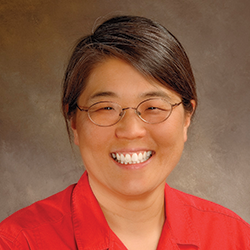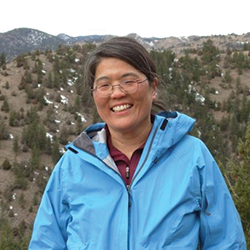Meet Natalie Ahn
, a professor of distinction at the University of Colorado, Boulder, was elected president of the ═╡┼─═╡┐· and ═╡┼─═╡┐· Biology in the summer of 2015. Her term begins July 1. Ahn previously served as a member of the ASBMB Council. Her lab uses proteomic, cell biology and biophysical approaches to uncover new signal-transduction mechanisms. She was a Howard Hughes Medical Institute investigator from 1994 to 2014. She spoke with ASBMB Today’s executive editor Angela Hopp, about her background and involvement with the ASBMB. This interview has been edited for length, style and clarity.
 Natalie Ahn is a professor of distinction at the University of Colorado, Boulder.
Natalie Ahn is a professor of distinction at the University of Colorado, Boulder.
What was your childhood like?
I grew up on U.S. military bases in Korea and Japan. My father emigrated from Korea and worked at the U.S. embassies in Seoul and Tokyo. My mother was a finance clerk at the embassy. I have one brother who’s an engineer and builds airplanes.
I was always interested in science. When John Glenn became the first American to orbit the Earth, I remember riding my tricycle and thinking that I too wanted to be an astronaut. Later, when I became an assistant professor at the University of Colorado, three of my first lab members had segued into biochemistry after first starting in aerospace engineering. So I appreciate how NASA and other big-science efforts promote science by inspiring kids.
Tell us about your education and training.
After finishing a high school degree overseas, I majored in chemistry at the University of Washington in Seattle and did undergraduate research in X-ray crystallography with the late Lyle Jensen and protein hydrodynamics with David Teller. I obtained my Ph.D. in chemistry from the University of California, Berkeley, where I studied enzymology with Judith Klinman. Judith is an incredibly deep thinker as well as a generous and courageous individual who continues to be one of my greatest inspirations.
My first postdoctoral job was with Christoph de Ha├лn at the University of Washington, where I studied hormone receptor binding. Christoph was unable to renew his funding and had to close his lab, and that’s how I learned about the importance of grants! He ended up great anyway, eventually becoming director of preclinical research at Bracco and director of the Milano Research Center. I then moved to the lab of the late Edwin Krebs for a second postdoc, where I was among the first to describe MAP kinases and MAP kinase kinases. That started my career in signal transduction.
Tell us a little about your current work.
I still work on MAP kinase and other signaling pathways. When I started at the University of Colorado, I began applying the new technology of protein mass spectrometry to address questions in signaling. This was done in collaboration with my late partner, Katheryn Resing. My lab’s applications of proteomics to signal transduction have led to broad discoveries, ranging from new mechanisms for cell regulation to mechanisms for allosteric control of MAP kinases.
How did you get involved with the ASBMB in the first place?
I attended the ASBMB annual meeting during my graduate studies, and it was at this meeting that I gave my first public research talk and got to meet the leaders in enzymology. That was a spectacular experience. When at the end of my first postdoc I had no way to pay for an accepted manuscript, the Journal of Biological Chemistry generously waived page charges, allowing me to publish. Since then, I’ve helped organize symposia at the annual meeting and served on the ASBMB Council. It was the support by the ASBMB during the crucial early years of my career that engendered my long-lasting love for this society.
How would you describe your leadership philosophy or style? Do you see any crossover of your lab leadership style in your approach to leading a scientific society?
I try to be involved in every aspect of my lab, but I let my students and postdocs — currently eight in all — work independently enough to discover their strengths, while following behind to support them. That’s not too different from the way I view leadership elsewhere, where my instinct is to try to solve the most important problems and avoid fixing what’s not broken.
 Ahn received her education and training in the western U.S. and now teaches at the Unviversity of Colorado.PHOTOS COURTESY OF NATALIE AHN
Ahn received her education and training in the western U.S. and now teaches at the Unviversity of Colorado.PHOTOS COURTESY OF NATALIE AHN
The ASBMB has had some pretty outspoken, political and provocative presidents. It’s also had diplomatic, some might even say reserved, presidents. What kind of president do you want to be?
I’m not a flashy or provocative person, although I am unafraid of taking a stand when it’s important. As president, I plan to focus on gaps and weaknesses at the ASBMB and the detailed steps needed to address them.
What are your priorities as president of the ASBMB?
Right now, we have three priorities. First is to recapture the annual meeting’s reputation as a must-attend event. Second is to expand our visibility and membership, especially among young investigators. Third is to restore the prominence and stature of the Journal of Biological Chemistry, where we’ve been fortunate to appoint Lila Gierasch as editor-in-chief and Fred Guengerich as deputy editor.
There’s a lot of competition among associations today. What do you think makes the ASBMB stand out in the crowded field?
The ASBMB has profoundly influenced discovery, and the importance of BMB in our current era is growing, not shrinking. This is obvious just by looking at the approximately one-third of human open reading frames and majority of noncoding RNAs whose functions are unknown and the overwhelming numbers of new regulatory connections generated from large-scale studies. Our discipline is the cornerstone of what’s needed to discover the functions of new molecules and mechanisms underlying their connections.
When you’re out there in the world, how do you describe the value of being an ASBMB member?
Many researchers, especially new investigators, may not be aware of the pivotal contributions of ASBMB members to current knowledge and how much the society has done and continues to do to promote everyone’s careers and to advocate for the support that allows them to do their work. That’s what I want to communicate — that ASBMB has benefitted every individual and that, in order to continue doing so, it is essential for all of us to be fully engaged with the society.
It’s our custom to ask senior scientists what kind of advice they offer their students. What’s yours?
I tell my students to envision what they want and where they want to be, then work backward to figure out how to get there. I can’t say that I’ve always done this myself, because I tended to put one foot in front of the other and follow my curiosity, taking opportunities as they came. It took me awhile to learn how goal-driven the rest of the world is. But it’s taught me a lot, and if I were a student now I would appreciate the advice. Second, never stop believing in yourself. When everything seems to fall apart, make a list of what you have that you’re grateful for, and then keep going.
Enjoy reading ASBMB Today?
Become a member to receive the print edition four times a year and the digital edition monthly.
Learn moreGet the latest from ASBMB Today
Enter your email address, and weтАЩll send you a weekly email with recent articles, interviews and more.
Latest in People
People highlights or most popular articles

Meet Robert Helsley
The Journal of Lipid Research junior associate editor studies chronic liver disease and was the first in his family to attend college.

Exploring lifeтАЩs blueprint: Gene expression in development and evolution
Meet Julia Zeitlinger and David Arnosti тАФ two co-chairs of the ASBMBтАЩs 2025 meeting on gene expression, to be held June 26-29, in Kansas City, Missouri.

ASBMB names 2025 fellows
═╡┼─═╡┐· and ═╡┼─═╡┐· Biology honors 24 members for their service to the society and accomplishments in research, education, mentorship, diversity and inclusion and advocacy.

When Batman meets Poison Ivy
Jessica Desamero had learned to love science communication by the time she was challenged to explain the role of DNA secondary structure in halting cancer cell growth to an 8th-grade level audience.

The monopoly defined: Who holds the power of science communication?
тАЬAt the official competition, out of 12 presenters, only two were from R2 institutions, and the other 10 were from R1 institutions. And just two had distinguishable non-American accents.тАЭ

In memoriam: Donald A. Bryant
He was a professor emeritus at Penn State University who discovered how cyanobacteria adapt to far-red light and was a member of the ═╡┼─═╡┐· and ═╡┼─═╡┐· Biology for over 35 years.

